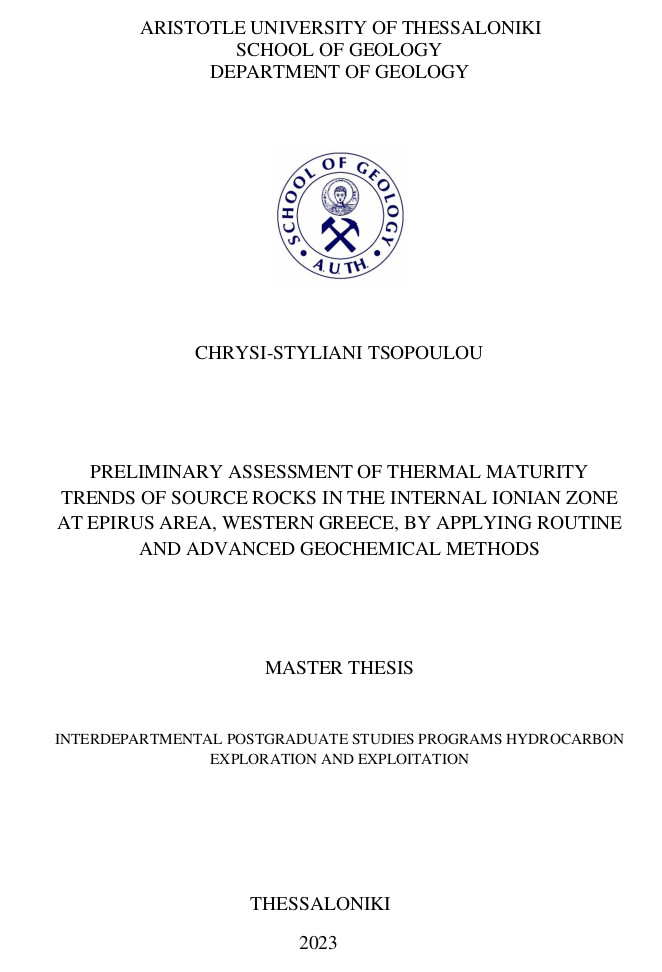
Preliminary assesment of thermal maturity trends of source rocks in the internal Ionian zone at Epirus area, Western Greece, by applying routine and advanced geochemical methods = Αρχική εκτίμιση των τασεων της θερμικής ωριμότητας των μητρικών πετρωμάτων στην εσωτερική Ιόνια ζώνη στην περιοχή της Ηπείρου, στη Δυτική Ελλάδα, Εφαρμόζοντας κλασθκές και προχωρημένες γεωχημικές μεθόδους .
Περίληψη
Η Ιόνια λεκάνη βρίσκεται στη δυτική Ελλάδα και αποτελεί τμήμα των εξωτερικών Ελληνίδων ζωνών. Στη Μεσοζωϊκή ανθρακική σειρά παρατηρούνται στρώματα ικανά για τη γένεση υδρογονανθράκων. Στρωματογραφικά, τα μητρικά πετρώματα παρατηρούνται στο ανώτερο τμήμα των Τριαδικών εβαποριτών, στο κατώτερο τμήμα των Ιουρασικών ασβεστολίθων (σχιστόλιθοι Παντοκράτορα), στο ανώτερο τμήμα των Ιουρασικών ασβεστολίθων (Ποσειδώνια ή Ammonitico rosso) και στο ανώτερο τμήμα των κατώτερων Κρητιδικών ασβεστολίθων (Βίγλα). Οι παλαιογεωγραφικές συνθήκες στην περιοχή ελέγχονταν από διάφορους παράγοντες, οι οποίοι ευνόησαν τη στασιμότητα των υδάτων, την ανάπτυξη οξειδοαναγωγικών συνθηκών στον πυθμένα, το σχηματισμό και την διατήρηση του οργανικού υλικού. Τα εργαστηριακά αποτελέσματα τόσο από την πυρόλυση Rock Eval όσο και από τις μεθόδους γεωχημείας (βιοδείκτες πετρελαίου) των μητρικών πετρωμάτων μελετώνται σε αυτή την εργασία, ώστε να προσδιοριστούν οι μεταβολές της ωριμότητας από τα ανατολικά προς τα δυτικά στην Ιόνια ζώνη. Τα δείγματα αναλύθηκαν με το όργανο Rock Eval II και με τη χρήση πλήρους σάρωσης αερίου χρωματογραφίας μάζας (GCMS). Τα διαγράμματα που έγιναν για τα Ιουρασικά και Κρητιδικά μητρικά πετρώματα με τη μέθοδο της Rock Eval πυρόλυσης, συνδυάστηκαν με την ανακλαστικότητα του βιτρινίτη (Ro%), το δείκτη προτίμησης άνθρακα (CPI), το δείκτη μεθυλοθεναμφρίνης (MPI) και ποικιλία τάξεων βιοδεικτών. Τα αποτελέσματα έδειξαν ότι στα μητρικά πετρώματα κυριαρχεί κηρογόνο τύπου I, II και αναμεμιγμένο I-II το οποίο αποτέθηκε σε θαλάσσιο ως χερσαίο περιβάλλον αντίστοιχα. Η ωριμότητα των μητρικών πετρωμάτων τείνει να μειώνεται από την εσωτερική προς την κεντρική-εξωτερική Ιόνια ζώνη, σύμφωνα με τα παραγόμενα αποτελέσματα. Επιπρόσθετα η Ιόνια ζώνη στη δυτική Ελλάδα συγκρινόμενη με την νοτιοανατολική Αδριατική περιοχή (Κροατία, Αλβανία, Ιταλία) δείχνει ένα παρόμοιο ανθρακικό- εβαποριτικό περιβάλλον παλαιογεωγραφικά, στο οποίο δημιουργήθηκαν υδρογονάνθρακες.
Πλήρες Κείμενο:
PDFΑναφορές
Cazzini F., Zotto O.Dal, Fantoni R., Ghielmi M., Ronchi P. and Scotti P.,2015.Oil and gas in the Adriatic foreland, Italy. Journal of Petroleum Geology, vol.38 (8), pp.255-279.
Cota L. and Baric G., 1998. Petroleum potential of the Adriatic offshore, Croatia. Org. Geochem. Vol. 29, No 1-3, pp.559-570 Elsevier Science Ltd.
Curi F., 1993. Oil generation and accumulation in the Albanide Ionian Basin. Generation, Accumulation and Production of Europe’s Hydrocarbons III =, A.M.Spencer, Special Publication of the European Association of Petroleum Geoscientists No.3. Springer-Verlang Berlin Heidelberg.
Georgakopoulos A. Petroleum Geology (courses in Greek). Aristotle University of Thessaloniki, Faculty of Science, School of Geology.
Getsos K., Pomoni-Papaioannou F. and Zelilidis A., 2004. Triassic carbonate and evaporite sedimentation in the Ionian zone (western Greece): palaeogeographic and palaeoclimatic implication. Bulletin of the Geological Society of Greece vol. XXXV I, Proceedings of the 10th International Congress, Thessaloniki, April 2004.
Karakitsios V. and Rigakis N., 1996. New oil source rocks cut in Greek Ionian Basin .Oil and Gas Journal.
Karakitsios V. and Rigakis N., 1998. The source rock horizons of the Ionian Basin (NW Greece). Marine and Petroleum Geology 15, pp.593-617 Elsevier Science Ltd.
Karakitsios V., 2013.Western Greece and Ionian Sea petroleum systems. The American Association of Petroleum Geologists, Vol.97, No 9, pp.1567-1595.
Karakitsios V., Marnelis F., Rigakis N., and Sotiropoulos Sp., 2013. Geological solutions concluded by petroleum geochemical data in Western Greece. Bulletin of the Geological Society of Greece, vol. XLVII 2013 Proceedings of the 13th Internationa
Congress, Chania, Sept.2013
Oikonomopoulos I., 2019. Organic Geochemistry (courses in Greek). Aristotle University of Thessaloniki, Faculty of Science, School of Geology, Interdepartmental postgraduate studies programs “Hydrocarbon exploration and exploitation”.
Rigakis N., 1999. Contribution to stratigraphic research on wells and outcrops of the alpine formations in western Greece, in relation to the petroleum generation efficiency of their organic matter. School of Geology, National and Kapodistrian University of Athens. (In Greek).
Scisciani V. and Esestime P., 2017. The Triassic evaporites in the evolution of the Adriatic Basin. Permo-Triassic Salt Provinces of Europe, North Africa and the Atlantic Margins, Chapter 23, pp.499-513 Elsevier Inc.
Telo Velaj, 2015. New ideas on the tectonic of the Kurveleshi anticlinal belt in Albania, and the perspective for exploration in this subthrust. Petroleum 1, pp. 269-288 Elsevier on behalf of KeAi Communications Co., Ltd.
Εισερχόμενη Αναφορά
- Δεν υπάρχουν προς το παρόν εισερχόμενες αναφορές.
